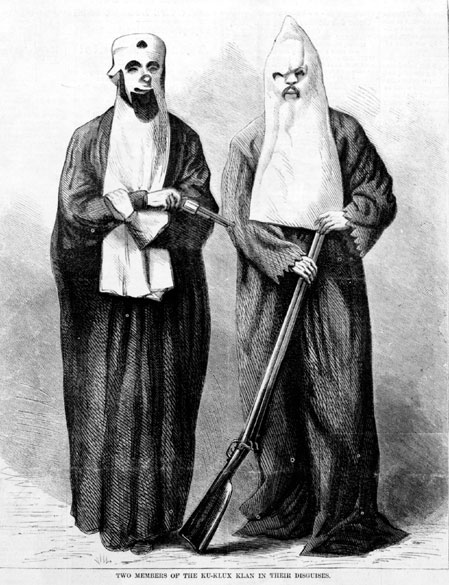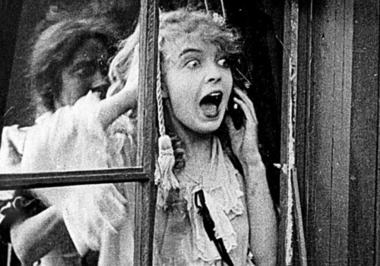Birth of a Nation, The Klan,
and the Rise of Racism
 To fully understand the impact of Birth of a Nation you need to know a little of the history of the KKK. The KKK was a brutal terrorist organization founded in 1866 for the purpose of strengthening white supremacy in the defeated Confederacy and using violence to suppress any attempt at Black equality. Between 1866 and 1872, it unleashed a campaign of terror that left between 2,000 and 3,000 dead and countless others brutalized. The KKK attacked Blacks as well as any whites who supported them, particularly school teachers. The federal government, under the presidency of the corrupt and deeply racist Andrew Johnson turned a blind eye to the activities of the Klan. When Grant came to power in 1869 he used federal power to suppress the Klan and jail many of its members. The Klan was destroyed and officially disbanded in 1872. Although violence against Blacks certainly continued, there was no KKK in the United States for the rest of the 19th century and into the early 20th century. However, among white Southerners the Klan was both remembered and romanticized.
To fully understand the impact of Birth of a Nation you need to know a little of the history of the KKK. The KKK was a brutal terrorist organization founded in 1866 for the purpose of strengthening white supremacy in the defeated Confederacy and using violence to suppress any attempt at Black equality. Between 1866 and 1872, it unleashed a campaign of terror that left between 2,000 and 3,000 dead and countless others brutalized. The KKK attacked Blacks as well as any whites who supported them, particularly school teachers. The federal government, under the presidency of the corrupt and deeply racist Andrew Johnson turned a blind eye to the activities of the Klan. When Grant came to power in 1869 he used federal power to suppress the Klan and jail many of its members. The Klan was destroyed and officially disbanded in 1872. Although violence against Blacks certainly continued, there was no KKK in the United States for the rest of the 19th century and into the early 20th century. However, among white Southerners the Klan was both remembered and romanticized.
The picture at the left is from an 1868 magazine and shows typical Klan robes of that era. The 20th century KKK and all of the symbolism and paraphernalia that goes with it is directly related to Birth of a Nation. The KKK was refounded in 1915 by William Joseph Simmons (1880-1945). Simmons was directly inspired by Birth of a Nation which he watched repeatedly before getting the idea of refounding the Klan. He and his followers and imitators took their queues directly from Griffith. Klan uniforms became more or less standardized along the lines shown in the movie. The original Klan never burned a cross. But, it was done in the movie so the new KKK did it.
The new KKK was different from the original version in another critical way. The original KKK had been simplemindedly devoted to suppressing every possible instance of Black freedom, but uninterested in anything else. The new KKK continued the tradition of violent suppression of Black America but added attacks, both physical and rhetorical, on anyone who was not a White Anglo-Saxon Protestant. They attacked Catholics, Jews, Asians, and pretty much anyone who was not exactly like them. They were fervently anti-immigrant. They insisted that they alone were "real Americans." The new Klan was much, much larger than the original. KKK membership peaked in 1925 at about 5,000,000. The total population of the country then was about 114 million. In some places such as Muncie, Indiana, about 40 percent of white men were Klan members (the bottom of this page gives you more info about the KKK in San Marcos).
Of course another difference... The original KKK was disbanded in 1872. The one founded in 1915, and its many offshoot organizations, is with us still.
 Birth of a Nation resulted in a dramatic increase in racist attacks in the United States. Because the movie toured in specific places and was prohibited in others, we can actually have a pretty good idea of how inflammatory it was and how it directly resulted in the formation of hate groups and the deaths of African-Americans.
Birth of a Nation resulted in a dramatic increase in racist attacks in the United States. Because the movie toured in specific places and was prohibited in others, we can actually have a pretty good idea of how inflammatory it was and how it directly resulted in the formation of hate groups and the deaths of African-Americans.
Desmond Ang has studied the relation between Birth of a Nation and the formation of "klaverns," new units of the KKK as well as the relationship between showings of the film and lynchings. Birth was shown in 606 counties in 1915, but there were many, many places where it wasn't shown, and it was entirely banned in Kansas. Ang shows that when a film was shown in a county, lynchings in that county rose an average of 500% the following month. Ang's work controlled for demographics, the number of historical lynchings, and voting patterns. He still found that places that showed the film more were more likely to have new KKK klaverns in the following years. Kansas, the only state to ban the film, saw no increase in KKK activity.
The effects of the film on Klan development were extremely persistent. Ang compared places that had similar demographics in 1915 when the film was first shown. He found that, in 2000, the chances that a county had an active KKK presence were 18% greater where the film was shown than where it wasn't.
Even further, in the first decades of the 21st century, white supremacist groups and hate crimes have continued to be more common in places where the film was shown than where it was not. Ang concludes that "...historical showings of The Birth of a Nation continue to predict the presence of white supremacist groups and the prevalence of anti-minority hate crimes in the 21st century" Ang's complete report is available on the web at: https://scholar.harvard.edu/files/ang/files/ang_birthofanation_nov2020.pdf
THE KKK IN SAN MARCOS IN THE 1920s (not required reading)
San Marcos was caught up in the general KKK fever of the era. In the early 1920s San Marcos openly welcomed the Klan and the local newspaper The San Marcos Record published letters from KKK members assuring people that the KKK supported all worthy causes, but also had a secret committee to report "wrongdoing" by any citizen.
The highpoint of the KKK in San Marcos occurred on July 22, 1924 when the city hosted a massive KKK rally attended by more than 20,000. It was the biggest Klan rally ever held in Central Texas and one of the larger held nationally. Here's how the San Marcos newspaper reported the rally
“Monday was the red letter day in San Marcos Ku Klux Kan history. As had been advertised, a monster free barbecue was given to all Klansmen and families in the afternoon and at night the biggest Klan parade ever staged in a town of this size in Texas wound its way through the principal streets of the city… Extensive preparations were made to take care of the thousands of visitors which were expected. Most all of the business houses of the town carried a placard or banner with the words, “Welcome Klansmen” on it. Large banners were spread across the streets carrying welcome signs. A large electric cross was suspended at the northwest corner of the square which shone with brilliance after dark. According to statements heard from visitors, no other city has ever extended such a welcome to Klansmen, and throughout the parade groups of Klansmen cheered San Marcos…Much praise has been given local fire department members who acted as traffic officers throughout the day. They also secured barrels that were placed conveniently about the city and filled with ice water for the visitors.”
The early 1920s were the height of popularity of the Klan in the United States. In 1923, the Texas KKK had a paid membership of 150,000 and controlled city governments in Dallas, Fort Worth, and Wichita Falls. It probably had a majority in the Texas House of Representatives. However, the Klan rapidly lost popularity after D. C. Stephenson (1891-1966), its most prominent national leader, was convicted of kidnapping, raping, and murdering his secretary Madge Oberholtzer in 1925. By 1928 the Texas membership had fallen to about 2,500 and it fell much further in the following decade. Though the Klan never achieved its previous prominence, racism remained strong in Texas and in San Marcos. According to testimony from interviews collected by the Institute of Texan Cultures, San Marcos was not a "sundown town," that is, a town where Black people were forbidden to live and any Black person found within city limits after dark would be attacked. However, in the early 1930s it was a town where it was risky for Black people to be outdoors after dark.
The modern town of San Marcos was founded in 1851 by slave owning families. In the its early years there were roughly even numbers of white settlers and enslaved Black people. Through the late 19th century, a fairly high percentage of the city's population was Black (HOWEVER, the city was VERY small. In 1900, there were about 2,250 people living here). Much of the city's Black population joined The Great Migration, fleeing north to greater opportunity and less overt racism. At the same time Black people were fleeing, white and Mexican-American people were arriving. The town grew but remained relatively small (under 10,000) until after the end of World War II, and then began to grow relatively rapidly. San Marcos has boomed since the late 1970s, its population rising from about 23,000 in 1980 to, likely now, almost 100,000. Today, there are more Black people living in San Marcos than at any time in its previous history, but Black people constitute a far smaller percentage of the population than they did at the turn of the 20th century.
Find more information on the KKK in Texas at https://www.tshaonline.org/handbook/entries/ku-klux-klan
And in San Marcos at https://www.sanmarcosrecord.com/article/20799,answers-to-go
There is also a nice small museum of African-American history in San Marcos called The Calaboose. It's well worth a visit. It features, among other things, a complete set of KKK robes.
The number of students at Texas State has also increased dramatically since the 1960s. Here's the number at the first fall semester of every decade starting in 1940:
1940, 1,441
1950, 2,013
1960, 2,653
1970, 9, 852 (so the 1960s was actually our biggest decade of growth, about 370%)
1980, 15,400
1990, 20,940 (about when I got here)
2000, 22,423
2010, 32,572
2020, 37,812
2024, 40,678